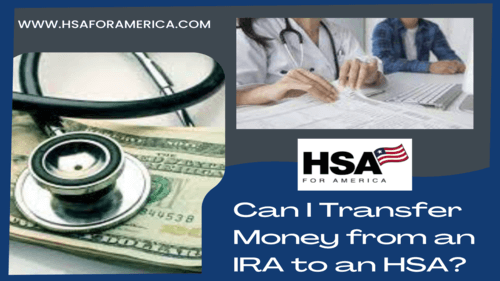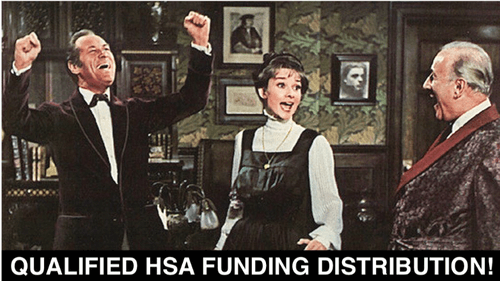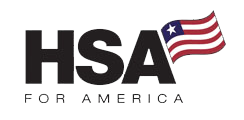If you’re facing a significant medical expense, and you don’t have enough money in an HSA to cover it already, I’ve got good news: The law allows every American taxpayer to make a once-per-life-time tax-free transfer (or “rollover”) from an IRA to an HSA.

They don’t call it a “rollover.” The technical term for a transfer from an IRA to an HSA is a QHSAFD, or qualified HSA funding distribution.

Transfer From IRA to HSA Guide
Making the transfer will allow you to pay the qualified medical expense with your newly-available HSA balance, without having to pay income taxes or early withdrawal penalties like you would if you had to take a distribution from your IRA.
Why Health Savings Accounts Are Awesome
Health savings accounts, or HSAs, are perhaps the most powerful and versatile tax-advantaged savings vehicles available today. They provide all the tax-deferral and other tax advantages of the familiar traditional Individual Retirement Arrangement, or IRA.
But they also have a powerful advantage that IRA’s don’t have: Unlimited tax-free withdrawals to pay qualified medical expenses.
That means HSAs bring triple tax advantages:
- No taxes on contributed earnings;
- Tax deferral as long as the money is in the account, and
- Tax-free withdrawals either now or in retirement for qualified medical expenses.
Under the law, you can make a one-time transfer of IRA assets to an HSA, up to the annual HSA contribution amount allowed for that year.
How Much Can I Transfer From an IRA to an HSA?
The maximum allowable HSA contribution limits for 2022 & 2023 are as follows:
- For 2023, the maximum HSA contribution limit is $3,850 for an individual, up from $3,650 in 2022.
- You can contribute up to $7,750 to a family HSA for 2023, up from $7,300 in 2022.
- HSA catch-up contribution max (for individuals age 55 or older) – $1,000.
The maximum amount you can transfer from an IRA to an HSA (or other eligible account via a QHSAFD) is the same as these limits, minus any previous HSA contributions that year.
HSAs vs. Flexible Spending Arrangements (FSAs)
Many flexible spending arrangements are “use it or lose it.” If you don’t use the money in your medical FSA (or other FSAs for that matter!) you risk forfeiting it back to your employer.
HSA contributions don’t go away. Once they’re in your account, you are in control. You don’t have to forfeit that money to anyone until you are ready to spend it.
Transfer From IRQ to HSA Eligibility
To be eligible to make a transfer from an IRA to an HSA, you must be enrolled in a qualified high-deductible health plan (HDHP).
Also, you cannot contribute more than the annual cap on HSA contributions in any one year. If you or your employer previously made some contributions to your HSA for the current year, your allowable QHSAFD is reduced by that amount.
Other retirement accounts and QHSAFDs
You can only initiate a QHSAFD from a traditional IRA, Roth IRA, inactive SEP, or inactive Simple IRA.
Not from a 401(k), 403(b), or any other type of tax-advantaged account.
But don’t let that stop you: You can still execute a QHSAFD by first doing a rollover from your eligible retirement account to a traditional IRA, and then doing the QHSAFD from that IRA.
There are no annual limits on the IRA rollover, but the HSA contribution limits will still apply to transfers from the IRA into the health savings account.
Note: SEP IRA and SIMPLE IRA accounts are eligible only if they are “inactive.” That means that no contributions to those accounts have been made within the current tax year.
Planners should be careful because it’s the employer who makes SEP and SIMPLE IRA contributions, not the employee.
Unless the tax-payer is self-employed and controls his or her own SEP or SIMPLE IRA, they may not be aware of what contributions their employer has already made.
Special Rules for Non-Deductible IRAs
You can only transfer pre-tax dollars from your IRA to an HSA using a QHSAFD. You can’t transfer after-tax dollars.
This means you can’t transfer your tax basis from non-deductible IRA contributions into a QHSAFD. The usual pro-rata rules on distributions from IRAs with non-deductible contributions in them don’t apply.
You should speak with your tax professional about the details of your basis in non-deductible IRAs and which funds from these accounts are eligible for a QHSAFD.
When is the deadline to make a QHSAFD?
Unlike IRA contributions, which give you until Tax Day in April of the following year to make contributions for this year’s IRA, you have to execute your QHSAFD by the end of December 31st of the current year.
That said, you might want to wait until the following year to do your QHSAFD. Why? Because next year, the HSA contribution cap is probably going to be higher. Which allows you to make a bigger QHSAFD. In turn, you would realize that much more in tax savings.
Unused HSA Funds Can Be Used for Retirement
If you’re confident you won’t need the money for anything other than medical expenses until retirement, and you aren’t contemplating a change in employment or changing your health care plan to anything other than a high-deductible health plan, there’s really no downside to contributing the maximum amount you can to your Health Savings Account each year, and making a QHSAFD along the way.
Investing HSA funds
It is possible to invest HSA funds in assets other than cash. There are HSA owners who invest their unused health savings account assets in index funds, money markets, bonds, gold and precious metals, and even real estate, via a third-party self-directed retirement account administrator.
HSA for America does not give investment advice, and is not recommending the purchase or sale of any security. This information is for general information purposes only. For further information on this topic, you should speak with a licensed investment advisor.
Transfer From IRA to HSA (QHSAFD) Testing Period
QHSAFDs are subject to a testing period. To qualify for the tax-free treatment of the distribution, you must maintain your eligibility for an HDHP and to make contributions to an HSA until the end of the 12th month following the year you make the QHSAFD.
If you’re no longer eligible to make HSA contributions, or if you expect to give up your eligibility within the next 13 months, it may not make sense to do a QHSAFD.
Compare Pricing on the Best HSA Plans Available
Other Uses for an HSA
Assets in a health savings account can be very handy as a “bridge” to Medicare. If you retire before becoming eligible for Medicare (usually, but not always, at age 65), you can use your HSA balance to pay any health care expenses tax-free.
That lessens the financial blow from both unexpected and routine medical expenses until you can sign up for Medicare and a Medigap plan that will help you with deductibles, co-insurance, co-pays, etc.
Once you are eligible for Medicare, you can use assets in your HSA to pay Medicare premiums, deductibles, and co-pays tax-free. That means your HSA funds are available to pay Medicare Part D prescription drug plan charges and Part B premiums and co-insurance, along with your Part B deductible.
You can also use tax-free HSA assets to pay certain premiums on qualified long term care insurance premiums – but not to to pay Medigap premiums.
What to Be Aware Of
First, early distributions from an HSA that are not attributable to a qualified medical expense get slapped with a 20% penalty. That’s twice the 10% penalty the IRS assesses on IRAs and other retirement accounts that don’t qualify for a hardship withdrawal.
Also, unlike IRAs, which don’t have an early withdrawal penalty after age 59½, health savings account early withdrawal penalties are in effect until you turn age 65.
So you’ll have to wait longer to have ready access to the money for general lifestyle spending.
But you can still use your HSA for qualified medical expenses at any time, tax and penalty free!
Contact the HSA Experts
At HSA for America, we’re built around helping our customers get the most value possible out of health savings accounts. We believe in free market health care solutions, and the power of free enterprise to solve health care delivery problems.
Our healthcare solutions, including HSAs, direct primary care plans, non-insurance health sharing plans, high-deductible health plans, and other tools are all designed to put power back in your hands – not the insurance company’s.
To learn more about the power of HSAs and other insurance and non-insurance alternatives, contact one of our experienced personal benefits managers today. Just click here to schedule a free, no-obligation consultation. There is never any cost to you.
Here are some additional articles on health savings accounts: How You Can Use Your HSA to Pay for Nutritional Supplements | The Huge Mistake You’re Making with Your HSA [Keeping Your HSA in Cash] | What Is a Health Care Savings Account?
Here are some additional pages related to this article: Get All Your Questions Answered About Health Savings Accounts | HSA Insurance Plans



